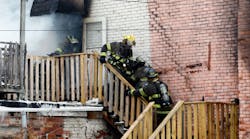Jan. 27--The deaths Sunday of two Toledo firefighters were the biggest single loss of lives in the line of duty since the 1961 explosion and deaths of four men on the Anthony Wayne Trail.
In the 177-year history of the Toledo Fire Department, 48 firefighters, including Sunday's victims, Stephen A. Machcinski, 42, and James Dickman, 31, have lost their lives in the line of duty.
The first fatality occurred in 1872, when James Welch fell from a ladder at a fire at Lafayette and Ottawa streets, according to Toledo Fire Department records. Tragedy struck the Welch family 59 years later when his son, also a firefighter, died in the line of duty.
Toledo's deceased firefighters are commemorated at the Toledo Fire and Rescue Department Memorial in Chub DeWolf Park across from Station No. 1, honoring 46 firefighters, as well as six others who died while on military duty.
The single largest loss occurred on June 10, 1961, when an overturned gasoline truck exploded on the Anthony Wayne Trail. Reports said the truck's speed caused the tanker to overturn and crash.
Retired fire Chief William Neeb, speaking at a 2011 memorial for the Trail fire, said the scene that greeted him was difficult to describe, 50 years later.
"Within moments, we were on the scene I can only describe as quite chaos," he recalled.
Killed were Robert Harrison, William Genson, Glenn Carter, and Deputy Chief Ewald Bode. The four men were injured and died days or weeks later.
Until Sunday's tragedy, the most recent firefighter to die while on duty was Michael Darrington, 45, whose Feb. 27, 2009, death was attributed to a heart attack.
Mr. Darrington, a 25-year veteran of the fire department, was found dead in the crew quarters' second floor of Station 14 after failing to report to an emergency call, fire officials said.
Before that, firefighter Donnie Cathcart died when he collapsed while fighting a central-city blaze on May 19, 1981. That blaze also claimed the life of an infant.
Each spring, on the anniversary of the Anthony Wayne Trail fire, the city holds a "last alarm" service at the downtown memorial that draws firefighters, retirees, and families from around the region.
During a 2009 memorial, Fire Chief Luis Santiago noted that firefighters are exposed to an elevated risk of heart problems.
In 2003, heart attacks and strokes were classified by federal law as a line of duty death, and Toledo fire officials began taking steps to ensure firefighters received proper commemoration on the memorial statue.
The federal Hometown Heroes Act sparked the study of firefighters' health risks and prompted Toledo to dig through station journals to uncover and reclassify on-duty heart attacks and other fatal ailments.
As a result, the Toledo Fire Department memorial lists 14 line-of-duty deaths attributed to heart attacks or other illnesses previously not considered directly caused by their duties.
The tragedy of Toledo's first firefighter's death was compounded nearly six decades later when Mr. Welch's son, Capt. Edward J. Welch, died while battling a blaze at Paddock Merchandise Co. at 114 St. Clair St., fire records show.
The riskiness of firefighting is highlighted by the nature of those 48 deaths.
After heart and other ailments, 12 firefighters died during various operations that fire records often didn't elaborate on.
Six firefighters died in falls and six others, including the Trail victims, died from burns. Capt. James Fraser burned to death at the King Elevator fire in 1894, and his body was never recovered.
Two firefighters died from falling walls and five died in collisions, including one after a collision with a streetcar on Collingwood Boulevard and Dorr Street in 1901. A second fireman died that year when he fell through the pole hole in Station 13 at Front and Payne streets.
A 1902 fire at Kiefer Brothers Furniture Store at Dorr and Palmwood Avenue claimed two lives. That same year in a separate incident, a firefighter died of injuries at a junk warehouse on Vance Street.
A steamer firetruck fatally ran over a fireman in 1916.
Capt. Andrew Flynn and fireman Bernard Orzechowski died when their rig collided with a Community Traction bus in 1932 and a third man died that year in a fall.
The highest ranking firefighters to die were Chief Karl B. Scheidler, who suffered a heart attack as a result of battling a marsh fire on Nov. 2, 1952; District Chief George Ehmann, who died from injuries suffered in a collision at Lincoln Street and Lawrence Avenue; Deputy Chief Claude Willoughby, who died of a heart attack during a fire at 916 Lagrange St. in 1969, and Deputy Chief Bode in 1961.
Contact Jim Sielicki at: [email protected] or 419-724-6050.
Copyright 2014 - The Blade, Toledo, Ohio






